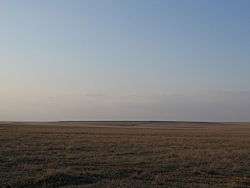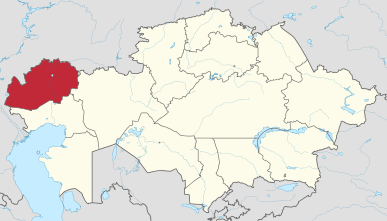West Kazakhstan Region
West Kazakhstan Region (Kazakh: Батыс Қазақстан облысы, romanized: Batys Qazaqstan oblysy; Russian: Западно-Казахстанская область, romanized: Zapadno-Kazakhstanskaya oblast) is a region of Kazakhstan. Its administrative centre is Oral (also known as Uralsk and Ural'sk), a city of about 200,000 inhabitants.
West Kazakhstan Region Батыс Қазақстан облысы Западно-Казахстанская область | |
|---|---|
 | |
 Coat of arms | |
 Map of Kazakhstan, location of West Kazakhstan Region highlighted | |
| Coordinates: 51°14′N 51°22′E | |
| Country | |
| Capital | Oral |
| Government | |
| • Akim | Gali Iskaliev |
| Area | |
| • Total | 151,339 km2 (58,432 sq mi) |
| Population (2013-02-01)[2] | |
| • Total | 618,261 |
| • Density | 4.1/km2 (11/sq mi) |
| Time zone | UTC+5 (West) |
| • Summer (DST) | UTC+5 (not observed) |
| Postal codes | 090000 |
| Area codes | +7 (711) |
| ISO 3166 code | KZ-ZAP |
| Vehicle registration | 07, L |
| Districts | 12 |
| Cities | 2 |
| Villages | 512 |
| Website | bko |
Geography
The region borders Russia and is near the Ural Mountains. The Ural River is the border between Asia and Europe and flows from Russia to the Caspian Sea through the region, meaning western West Kazakhstan is in Eastern Europe. West Kazakhstan region borders Aktobe Region to the east and Atyrau Region to the south, in addition to the following Russian Oblasts: Astrakhan Oblast to the south-west, Volgograd Oblast to the west, Saratov Oblast to the north-west, Samara Oblast to the north and Orenburg Oblast to the north-east.
It is traversed by the northeasterly line of equal latitude and longitude.
Demographics
West Kazakhstan has an ethnic Kazakh population of 69.8% and a significant Russian minority of 27.4% of the population. The number of Ukrainians, Poles and Germans are very low due to the geography.
Administrative divisions
The region is divided into twelve districts and the city of Oral.[3]
| Name | Population | Area (km²) | Population dens. | Capital | Continent |
|---|---|---|---|---|---|
| Akzhaik | 45,500 | 25,200 | 1,8 | Chapaev | both |
| Bokey Orda | 18,400 | 19,200 | 1,0 | Saykyn | Europe |
| Borili | 55,100 | 5,600 | 9,8 | Aksay | Asia |
| Kaztal | 39,200 | 18,600 | 2,1 | Kaztal | Europe |
| Karatobe | 19,700 | 10,000 | 2,0 | Karatobe | Asia |
| Zhanakala | 23,700 | 20,800 | 1,1 | Zhanakala | Europe |
| Zhanybek | 18,400 | 8,200 | 2,2 | Zhanybek | Europe |
| Shyngyrlau | 19,400 | 7,200 | 2,7 | Shyngyrlau | Asia |
| Zelenov | 53,700 | 7,400 | 7,3 | Peremyotnoye | Europe |
| Syrym | 26,500 | 11,900 | 2,2 | Zhympity | Asia |
| Taskala | 19,100 | 8,100 | 2,4 | Taskala | Europe |
| Terekti | 43,200 | 8,400 | 5,1 | Fyodorovka | both |
Two localities in the region have town status. These are Oral and Aksay.[3]
Sport
The capital Oral is home to Kazakhstan's only professional bandy club, Akzhaiyk. In 2016 the national championship was won by the regional team [4] and in the variety rink bandy, a national title was obtained in 2014.[5]
Investment potential of the region
In the first half of 2019, the gross regional product amounted to 1.4 trillion. tenge, which is 145 million tenge higher than last year. For 9 months of this year, industrial output amounted to almost 1.8 trillion. Tenge The development of the agro-industrial complex is also one of the drivers of the region’s economy. During the reporting period, the volume of regional gross product amounted to 118 billion tenge, which is 2% higher than last year. Livestock farming is the main direction of the agribusiness of the region. By the number of cattle of the meat sector of the region, it occupies the 2nd place in the Republic. If last year the cattle of the meat sector amounted to 456 thousand heads, this year this figure is 495 thousand heads. This year, to increase the number of livestock, it is planned to open feedlots for 15 thousand head of cattle. In general, today 42 large new investment projects worth over 1 trillion are being implemented in the region. tenge, with the creation of about 5 thousand jobs. Of these, 8 projects with foreign participation. This year, 10 projects will be launched for a total of 317.7 billion tenge with the creation of 500 jobs.
Cultural life of region
The West Kazakhstan region has a rich historical and cultural heritage. In the region, there are more than 6,000historical and archaeological sites of different eras and more than 500 historical, architectural and art monuments, 14 of which are monuments of national significance. In the field of culture and art of the region there are 717 state-run organizations. In order to study, preserve and popularize the historical and cultural heritage in the region there are 22 historical and local history and memorial museums, including 13 in rural areas. There are more than 377 public libraries with a total book stock of over five million books, unique manuscripts and publications.
References
- "Солтүстiк Қазақстан облысының ресми интернет-ресурсы | БАСТЫСЫ". Sko.kz. 2018-08-13. Retrieved 2018-08-18.
- Agency of statistics of the Republic of Kazakhstan: Численность населения Республики Казахстан по областям с начала 2013 года до 1 февраля 2013 года (russisch; Excel-Datei; 55 kB).
- История (in Russian). Западно-Казахстанская область. Retrieved 4 June 2012.
- "Сборная ЗКО стала чемпионом Казахстана по хоккею с мячом". Sports.kz. Retrieved 2018-08-18.
- "На чемпионате РК по ринк-бенди команда ЗКО заняла первое место".

